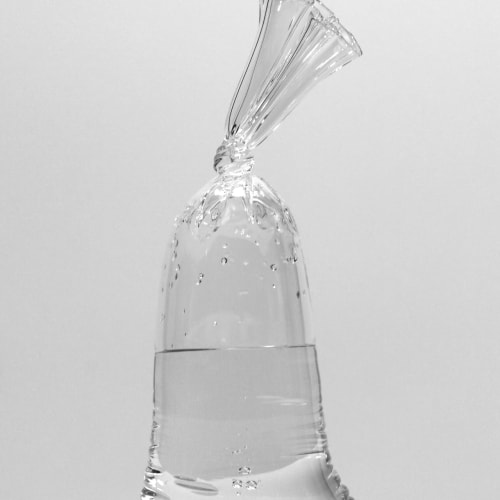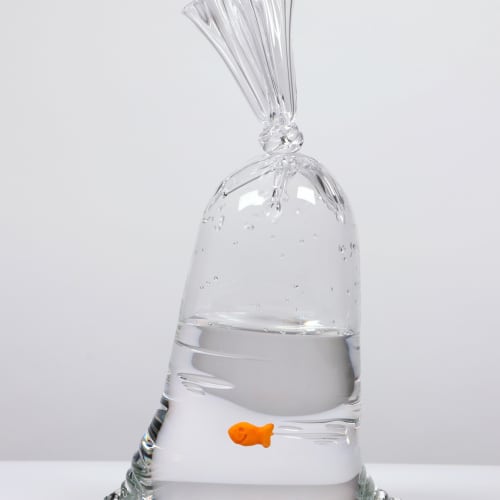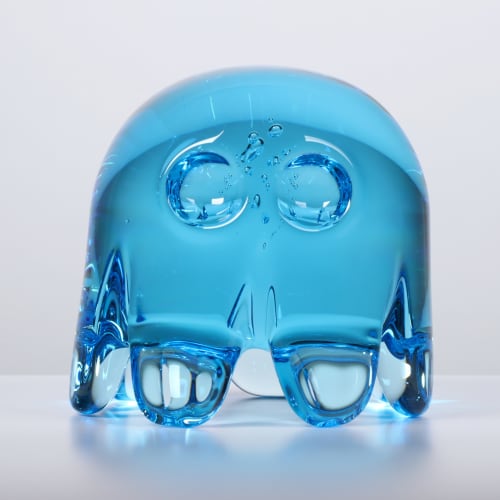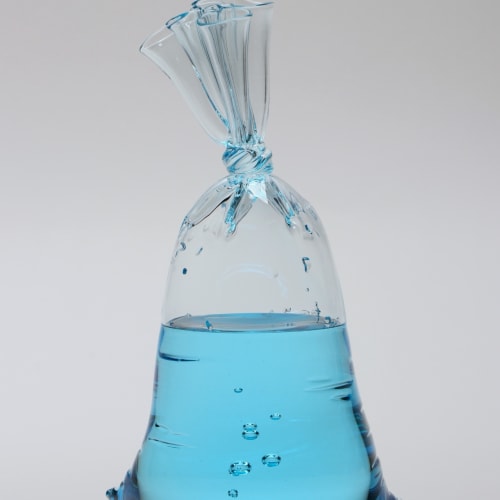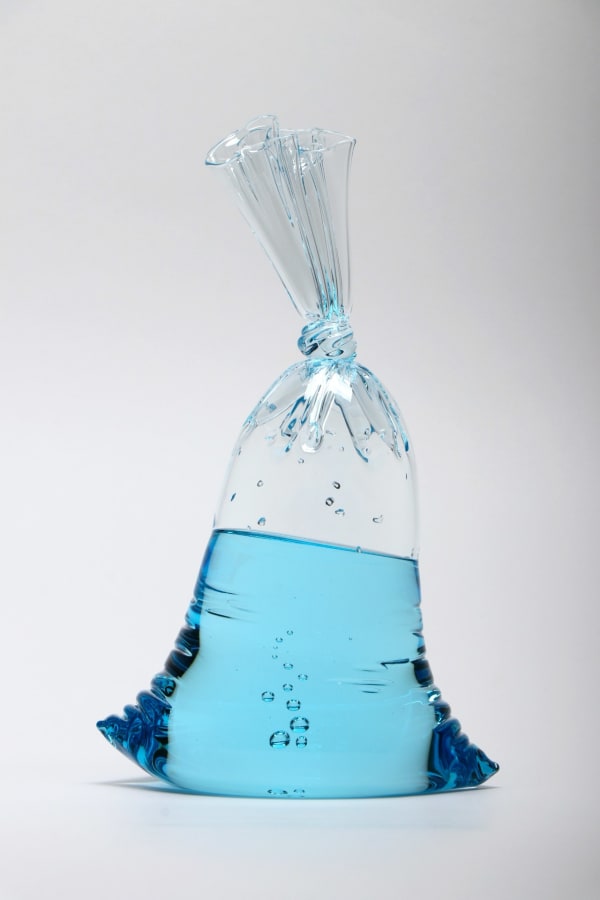You originally went to school for field science and outdoor education. What led you to make the switch to full-time artist?
I went to school with a strong curiosity for science. I have always been curious about the world and its inner workings. Even as a kid, I took things apart to see how they worked. My interest in science came late in high school and I really lacked mentorship. I didn’t know what branch of science I would be interested in so I decided the Broad Field Science major would provide a lot of exposure and I could focus on a branch when I found one that resonated with me.
I eventually haggled my way into the Intro to Glass art class, even though you needed to be an art major to take it. I think my interest in problem solving/scientific method and my abilities in athletics combined to give me an edge to learning how to work with hot glass. The extreme focus and determination required to work through the creation of a piece really drew me in. Glass blowing really resonated with me. I finished my science major and outdoor edu. minor while also spending all my free time in the glass studio. This was all around 2008 when the economy tanked. I was advised to consider another career path as studio artists were going out of business left and right. Iignored that advice and was just driven to continue learning and refining my skills. Opportunities came up and I followed them without much concern. I worked for other artists for years until I went to grad school(2014-17), afterwards I began working full time on my art.
I went to school with a strong curiosity for science. I have always been curious about the world and its inner workings. Even as a kid, I took things apart to see how they worked. My interest in science came late in high school and I really lacked mentorship. I didn’t know what branch of science I would be interested in so I decided the Broad Field Science major would provide a lot of exposure and I could focus on a branch when I found one that resonated with me.
I eventually haggled my way into the Intro to Glass art class, even though you needed to be an art major to take it. I think my interest in problem solving/scientific method and my abilities in athletics combined to give me an edge to learning how to work with hot glass. The extreme focus and determination required to work through the creation of a piece really drew me in. Glass blowing really resonated with me. I finished my science major and outdoor edu. minor while also spending all my free time in the glass studio. This was all around 2008 when the economy tanked. I was advised to consider another career path as studio artists were going out of business left and right. Iignored that advice and was just driven to continue learning and refining my skills. Opportunities came up and I followed them without much concern. I worked for other artists for years until I went to grad school(2014-17), afterwards I began working full time on my art.
What first attracted you to working with glass?
Molten glass is a pretty magical material. It cannot be manipulated unless it’s really hot so there’s a bit of a pyromania that’s attractive as well. But for me, it was building the discipline to master the material. It’s really hard to explain, glass working is like juggling while trying to solve a riddle with no breaks. There are at least 5 factors you need to be aware of, and tending to, at any given moment. All the while both hands are doing different tasks.
I think it’s ultimately the extreme physical and mental discipline required to control the material that drew me to it.
When working with glass you need to push your limits, therefore the material is pushed to the edge and there’s always a chance of going too far and ruining it. But, therein lies the pleasure.
When dealing with hot glass, it must be continuously moved and kept from cooling, with no time for breaks or pauses. How do you prepare for such a strenuous procedure?
It’s critical to reduce the amount of distractions. Definitely, go to the bathroom before getting started, lol. My assistant and I spend about an hour getting all our tools and equipment in order so everything is where it needs to be and ready before beginning a piece. I’ll have a meeting with my assistant(s) before starting so we’re on the same page for what I plan to do. Most of the color that I use, when I use color, takes about an hour to preheat, so that needs to be prepared beforehand. All other things just have to wait until the piece is finished.
How long has it taken to perfect your process?
Each form requires 100’s of iterations to refine. Glass blowing itself takes about 10 years to master the material. But glass artists typically say it can never be fully mastered and that’s part of the allure. There’s always another challenge to take on.
Do you go into the studio with a concept in mind, or does it come to you as you work?
For me it’s a bit of both. I can never fully predict the outcome of a new concept. I get a good idea of what I’m after and just start working. The glass will always have it’s own agenda and it takes time to figure out how to coax it into form. I like to work off the cuff and be open to subtle changes as I go. Sometimes the errors can lead to exciting new design avenues. There’s a duality that I enjoy. I strive for technical control and discipline but am always open to chance. It is this openness that leaves room for the magic.
H2O/SiO2 was originally inspired by the pet store/carnival fish that are given out in plastic bags. What made you decide to remove the fish?
I think the artwork is far more engaging without the fish inside. It not only leaves room for the viewer to insert their imagination, but also allows the work to be open to broader interpretations beyond the kitsch.
Do you find it harder to replicate an already existing object, like in H2O/SiO2 and Still Water, or to create something abstract/imagined, like in the Mach and Surge Series?
What I love about replicating an object is discovering where there is room to fudge the details. You only need to cue the brain to a few key elements and it will fill in the rest of the details. I nerd out a little on the psychology of perception.
Abstraction also plays with the mind in interesting ways. One of the reasons I am drawn to it is because it becomes a sort of canvas for the brain/subconscious to project upon. One could say it provokes the unconscious to come to the surface, at least for me.
You cite being red-green colorblind as what first made you interested in the perception of reality. When did you realize your reality was different?
I learned in elementary school that my vision was different. For years it felt like a deficit, as I matured through my teens I realized we’re all the same but different, like parallel universes. But still I did what I could to fit in and sneak by as most teenagers do. But it wasn’t until I gained the confidence to express myself that it really became an asset.
Are there any concepts or ideas you’re looking to explore in the future?
I have a few more fun Trompe l’oeil projects to refine and share. I am exploring complex optical sculptures. And I enjoy exploring unique experiential installations/sculptures that reimagine our relationship to common objects. There are a lot of ideas boiling under the surface, we’ll see which ones make it into the world.
FOR GENERAL AVAILABILITY AND ADDITIONAL INFORMATION ON Dylan Martinez, PLEASE CONTACT THE GALLERY AT +1 (212) 226-8680 OR INFO@GUYHEPNER.COM.
Each form requires 100’s of iterations to refine. Glass blowing itself takes about 10 years to master the material. But glass artists typically say it can never be fully mastered and that’s part of the allure. There’s always another challenge to take on.
Do you go into the studio with a concept in mind, or does it come to you as you work?
For me it’s a bit of both. I can never fully predict the outcome of a new concept. I get a good idea of what I’m after and just start working. The glass will always have it’s own agenda and it takes time to figure out how to coax it into form. I like to work off the cuff and be open to subtle changes as I go. Sometimes the errors can lead to exciting new design avenues. There’s a duality that I enjoy. I strive for technical control and discipline but am always open to chance. It is this openness that leaves room for the magic.
H2O/SiO2 was originally inspired by the pet store/carnival fish that are given out in plastic bags. What made you decide to remove the fish?
I think the artwork is far more engaging without the fish inside. It not only leaves room for the viewer to insert their imagination, but also allows the work to be open to broader interpretations beyond the kitsch.
Do you find it harder to replicate an already existing object, like in H2O/SiO2 and Still Water, or to create something abstract/imagined, like in the Mach and Surge Series?
What I love about replicating an object is discovering where there is room to fudge the details. You only need to cue the brain to a few key elements and it will fill in the rest of the details. I nerd out a little on the psychology of perception.
Abstraction also plays with the mind in interesting ways. One of the reasons I am drawn to it is because it becomes a sort of canvas for the brain/subconscious to project upon. One could say it provokes the unconscious to come to the surface, at least for me.
You cite being red-green colorblind as what first made you interested in the perception of reality. When did you realize your reality was different?
I learned in elementary school that my vision was different. For years it felt like a deficit, as I matured through my teens I realized we’re all the same but different, like parallel universes. But still I did what I could to fit in and sneak by as most teenagers do. But it wasn’t until I gained the confidence to express myself that it really became an asset.
Are there any concepts or ideas you’re looking to explore in the future?
I have a few more fun Trompe l’oeil projects to refine and share. I am exploring complex optical sculptures. And I enjoy exploring unique experiential installations/sculptures that reimagine our relationship to common objects. There are a lot of ideas boiling under the surface, we’ll see which ones make it into the world.
FOR GENERAL AVAILABILITY AND ADDITIONAL INFORMATION ON Dylan Martinez, PLEASE CONTACT THE GALLERY AT +1 (212) 226-8680 OR INFO@GUYHEPNER.COM.
November 27, 2023
